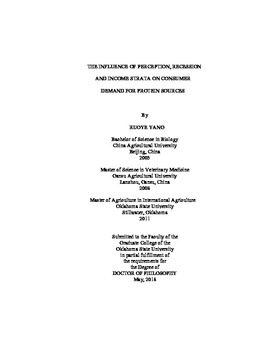| dc.contributor.advisor | Raper, Kellie | |
| dc.contributor.author | Yang, Ruoye | |
| dc.date.accessioned | 2019-03-25T21:59:35Z | |
| dc.date.available | 2019-03-25T21:59:35Z | |
| dc.date.issued | 2018-05 | |
| dc.identifier.uri | https://hdl.handle.net/11244/317777 | |
| dc.description.abstract | U.S. Consumers see retail beef products in the meat case labeled as produced with no added hormones (NAH). However, they also see similar labels on pork and chicken products despite the fact that added hormones are not used in pork and poultry production. Such labeling may mislead consumers to believe that hormones are used in pork and poultry production. This dissertation examines the impact of hormone use perception on consumer preference for meat products. Results suggest that consumer perceptions of hormone use in production are incorrect. Further, perception influences consumer preferences and willingness-to pay (WTP) for unlabeled products versus NAH labeled products. | |
| dc.description.abstract | Given that most consumers have little direct involvement in food production, many food choices are likely made with inaccurate beliefs regarding production claims. If consumers have factual information about food production to inform their perception, they may make different choices about products and WTP, potentially increasing utility. This dissertation demonstrates the impact of factual hormone use information on consumer preferences for meat products. Results reveal that after consumers receive factual hormone use information, demand for beef products decreases while demand for pork and chicken products increases. Consumers are willing to pay more for NAH labeled meat products both pre- and post-information. However, WTP premiums for NAH labeled pork chops and chicken breast become lower post-information. | |
| dc.description.abstract | A primary driver of consumer demand is income. The U.S. economy experienced a significant economic recession from December 2007 through June 2009. Median household income started to fall in 2007 and did not rise again until 2012. Consumers have multiple options to consider in rearranging their shopping basket to satisfy daily protein consumption under financial pressure. However, the timing of such behavioral change is unknown. Further, low, middle and high-income households may vary in protein source expenditure responses to financial pressure. This dissertation analyzes whether and how consumer demand for protein sources was impacted by the Great Recession. Results suggest the break date of expenditure patterns for protein sources is around October 2009. Changes of own-price and expenditure elasticities for protein sources are different for households across income quintiles after October 2009. | |
| dc.format | application/pdf | |
| dc.language | en_US | |
| dc.rights | Copyright is held by the author who has granted the Oklahoma State University Library the non-exclusive right to share this material in its institutional repository. Contact Digital Library Services at lib-dls@okstate.edu or 405-744-9161 for the permission policy on the use, reproduction or distribution of this material. | |
| dc.title | Influence of perception, recession and income strata on consumer demand for protein sources | |
| dc.contributor.committeeMember | Holcomb, Rodney | |
| dc.contributor.committeeMember | Henneberry, Shida | |
| dc.contributor.committeeMember | Vanoverbeke, Deb | |
| osu.filename | Yang_okstate_0664D_15718.pdf | |
| osu.accesstype | Open Access | |
| dc.type.genre | Dissertation | |
| dc.type.material | Text | |
| thesis.degree.discipline | Agricultural Economics | |
| thesis.degree.grantor | Oklahoma State University | |
